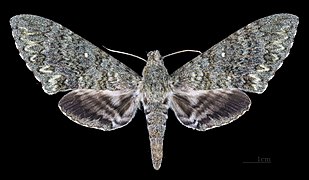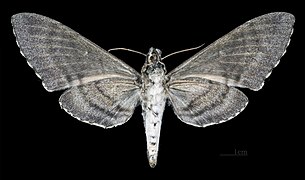
Manduca florestan, the Florestan sphinx, is a moth of the family Sphingidae. The species was first described by Caspar Stoll in 1782.

Manduca occulta, the occult sphinx, is a moth of the family Sphingidae.
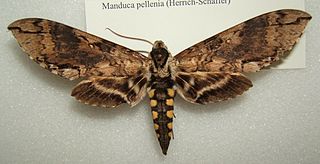
Manduca pellenia is a moth of the family Sphingidae. It is known from Mexico, Belize, Guatemala, Nicaragua, Costa Rica, Panama, Colombia and Ecuador.

Sphinx asellus, the asellus sphinx moth, is a moth of the family Sphingidae. The species was first described by Walter Rothschild and Karl Jordan in 1903. It is known from pinyon-juniper woodland and similar arid areas in the US states of Colorado, Nevada, Utah, extreme south-western Wyoming, Arizona, New Mexico and south-western Texas.

Lintneria istar, the Istar sphinx moth, is a moth of the family Sphingidae. The species was first described by Walter Rothschild and Karl Jordan in 1903. It is found in mountains and pine-oak woodlands from southern Arizona east to southern Texas and south through Mexico to Guatemala.

Sphinx vashti, the Vashti sphinx, is a member of the family Sphingidae of moths. It is found in North America from British Columbia east to Manitoba, south to southern California, Nevada, central Arizona, New Mexico and western Texas.

Aellopos clavipes, also known as the clavipes sphinx, is a moth of the family Sphingidae.

Enyo lugubris, the mournful sphinx, is a moth of the family Sphingidae. It is found from Argentina and Paraguay to Uruguay, Venezuela, Guyana, Suriname, French Guiana, Colombia, Ecuador, Peru, Brazil and the West Indies through Belize, Guatemala, Honduras, El Salvador, Nicaragua, Costa Rica and Panama to Mexico and the United States, where it has been recorded from Arizona east to Florida and north to South Carolina. Strays have been recorded from Arkansas, north to Illinois, Michigan and New York.

Eumorpha capronnieri is a moth of the family Sphingidae first described by Jean Baptiste Boisduval in 1875.

Eumorpha vitis, known as the vine sphinx, is a moth of the family Sphingidae.
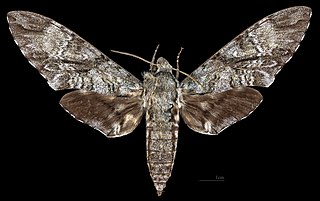
Manduca barnesi is a moth of the family Sphingidae.

Manduca clarki is a moth of the family Sphingidae first described by Walter Rothschild and Karl Jordan in 1916. It is known from Brazil, Colombia, Ecuador, Peru and Bolivia.

Manduca dalica is a moth of the family Sphingidae.

Manduca dilucida is a moth of the family Sphingidae first described by William Henry Edwards in 1887.

Callionima parce, the parce sphinx moth, is a species of moth in the family Sphingidae.It was originally described by Johan Christian Fabricius in 1775.

Eupyrrhoglossum sagra, the Cuban sphinx, is a moth of the family Sphingidae. The species was first described by Felipe Poey in 1832. It is known from tropical and subtropical lowlands in Cuba and from Mexico and Belize to Guatemala, Costa Rica, Bolivia, Paraguay, Argentina and Uruguay. Occasionally, strays are found in Florida.
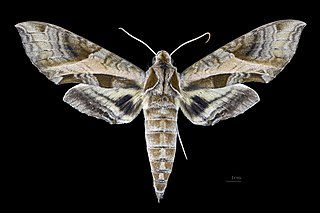
Eumorpha megaeacus is a moth of the family Sphingidae.
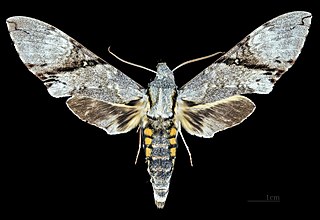
Manduca lefeburii is a moth of the family Sphingidae.
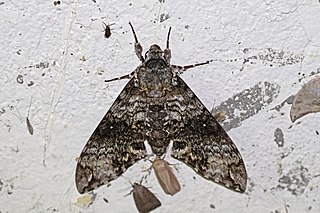
Manduca schausi is a moth of the family Sphingidae. It is found from Mexico, Guatemala, Nicaragua and Costa Rica to Brazil, Argentina and Bolivia.
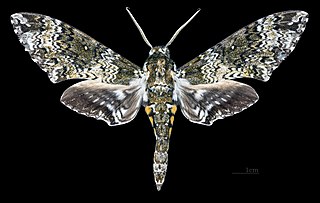
Manduca sesquiplex is a moth of the family Sphingidae. It is known from Mexico, Costa Rica and Nicaragua.


